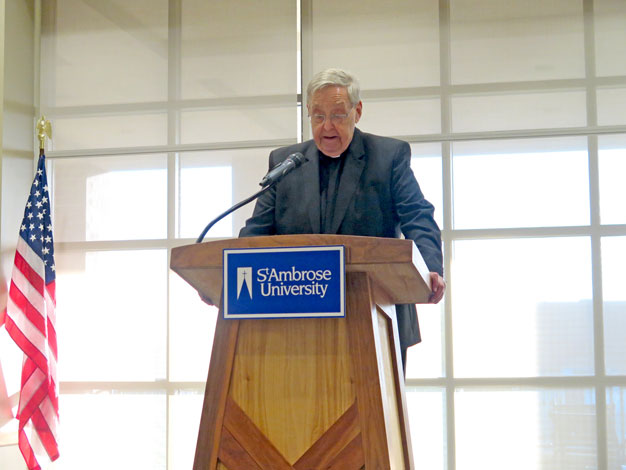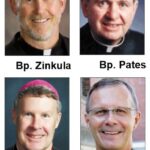
Father George McDaniel speaks at Sacred Heart Cathedral’s Red Dinner June 24 in the Rogalski Center on the St. Ambrose University campus in Davenport.
By Anne Marie Amacher
The Catholic Messenger
DAVENPORT — Historian Father George McDaniel took guests at Sacred Heart Cathedral’s Red Dinner on a journey through time into the lives of the early parishioners, ordinary as well as extraordinary. The retired St. Ambrose University history professor was the keynote speaker at the June 24 dinner in the Rogalski Center on the university’s campus. The dinner followed Mass at the cathedral at which Bishop Thomas Zinkula presided. Funds from the annual event assist with the ongoing needs of the cathedral, the mother church of the diocese.
Names of donors of the cathedral’s Stations of the Cross provided the framework for the historical journey. The most important story to share, Father McDaniel told the gathering, was about the “the people of the cathedral, those who gathered over the decades to worship; to support one another, their neighborhood and their community. The people who gathered to celebrate and to mourn the important times in their lives. Those people are the important history of the cathedral.”
People like George Conklin, the proprietor of the Atlantic House Hotel; Dan Ryan, a contractor; Michael Renihan, a plasterer; Joseph Loughran, a cabinet maker; Patrick McBride, a grocer; Cornelius Marinan, a grocery store owner; William Finch, a grain dealer; and Joseph Littig, a farmer, among them. Merchant Louis Schneider, father of Mary Francis Schneider, 15, probably made a donation to honor his only child, Father McDaniel said.
Most of the early parishioners lived in the Cork Hill neighborhood. “Some were real Iowa pioneers. Horace Bradley was born in New Haven, Connecticut, in 1815 and came to the Iowa Territory in 1838. He purchased land four miles out on Middle Road where he lived until his death in 1898. In 1839, as a lieutenant in the new Iowa militia, he marched south to defend Iowa Territory against incursions by Missourians in the Iowa Border War.”
Some parishioners were transplants from the New England and Mid-Atlantic States, taking advantage of the opportunity of open land, growing river commerce and a burgeoning road and railroad system, including the first bridge anywhere across the Mississippi River, built in 1856. Others were German and Irish immigrants fleeing economic hardships and political unrest in their homelands.
“Many of those immigrants settled on the east side of Davenport on the bluffs above the new railroad bridge.” Since many of them were from Ireland, the area became known as Cork Hill. At first, they worshiped at St. Anthony Parish downtown, but eventually a new parish was needed on the east side.
Antoine LeClaire, a principal founder of Davenport, donated a square block on the edge of downtown in 1839, the site where St. Anthony Church was built. In 1856, he gave land and $1,000 to build St. Marguerite Church, named in his wife’s honor, on the east side. As the church grew, newly ordained Father Henry Cosgrove arrived as assistant pastor of St. Marguerite and later became the second bishop of the Diocese of Davenport.
After Pope Leo XIII created the Davenport Diocese in 1881, newly ordained Bishop John McMullen arrived from Chicago to serve as the diocese’s first bishop. Even before his arrival, he chose St. Marguerite as his cathedral. Bishop McMullen died just two years later at age 51. “At the end of the (funeral) Mass, the body was lowered through the floor of the sanctuary to a tomb directly below the altar. A few years later, the bishop’s remains were taken to the new cathedral (Sacred Heart) and in 1944, they were moved to the new priests’ circle at Mount Calvary Cemetery, where hopefully, McMullen’s earthly journeying is now completed,” Father McDaniel said.
As the congregation grew, plans got underway in 1889 to build a new cathedral at an estimated cost of $80,000-$100,000. Father Andrew Trevis returned as pastor to St. Marguerite, but retired due to declining health. His successor, Father James Davis, described as young, energetic and perceived to be a good fund-raiser, became pastor of St. Marguerite. He was tasked with building the new cathedral.
Its construction led to a name change, Sacred Heart Cathedral. Both Father Trevis and Bishop Cosgrove had a devotion to the Sacred Heart, the First Friday devotion in the parish was popular and the League of the Sacred Heart had a large membership. “All of those factors may have led the bishop to petition Rome to change the name to the Cathedral of the Sacred Heart. On Dec. 23, 1889, Pope Leo XIII issued a decree allowing the change but mandating that a chapel had to be maintained that was dedicated to St. Marguerite.”
Sacred Heart Cathedral’s cornerstone was laid April 27, 1890, and the dedication ceremony took place Nov. 15, 1891. An estimated 1,200 people participated in the dedication ceremonies, Father McDaniel said. Bishop Cosgrove celebrated the solemn High Mass and Bishop John Hennessy of Dubuque preached the dedication sermon. That evening the cathedral choir sang a sacred concert and Bishop John Spalding of Peoria delivered a lecture.
“As I thought about the people whose names are on those plaques, they became for me the representatives of their generation of the people of the cathedral,” Father McDaniel reflected. “They represented the “first communicants with their long white veils; the school medal winners; the people who celebrated family weddings and funerals and baptisms; those boys and their parents who sent them to St. Marguerite’s School and then to the new St. Ambrose College.” They were representative of the people “who served on committees and those who regularly cleaned the church; and the people who came Sunday after Sunday, week after week, month after month, year after year to ‘their’ parish, but whose names did not end up on a brass plaque.”











